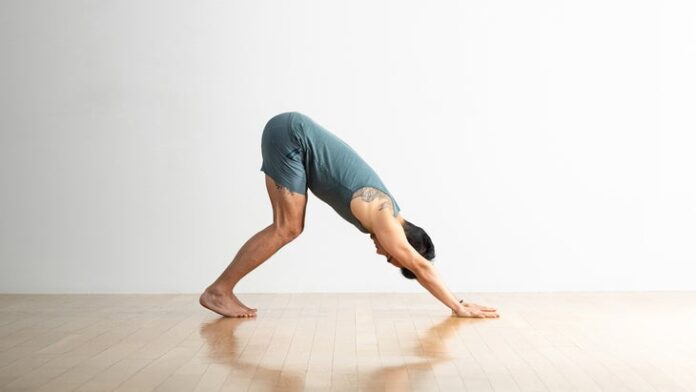“], “filter”: { “nextExceptions”: “img, blockquote, div”, “nextContainsExceptions”: “img, blockquote, a.btn, a.o-button”} }”>
Heading out the door? Read this article on the new Outside+ app available now on iOS devices for members!
>”,”name”:”in-content-cta”,”type”:”link”}}”>Download the app.
Most marathon runners I know (myself included) tend to have three things in common—an overwhelming desire to run, a struggle with post-training stiffness, and a dislike of stretching.
But as a running coach and personal trainer, I can also tell you that ample evidence suggests that practicing post-run stretches can help prevent delayed-onset muscle soreness (DOMS). That’s the discomfort that typically develops 24 to 48 hours following exercise due to microscopic tears in the muscle tissue and the resultant inflammatory process. Stretching increases circulation and brings more oxygen and nutrients in response to damage from your workouts. It also shuttles away metabolic byproducts.
Taking just a few minutes for post-run stretches also increases your range of motion, which refers to how much mobility or movement you have surrounding a joint. When your muscles and connective tissues prohibit range of motion, the resulting stiffness can limit how fluidly you run and put you at risk for injury. Research also supports stretching as a way of reducing the risk of injury from excessively tight muscles.
And yes, you need to hold the stretch for at least a count of 10. The static hold in a stretched position activates sensory receptors (such as muscle spindles and Golgi tendon organs (GTOs) in muscles, tendons, and ligaments. These receptors relay signals to the central nervous system, which signals the muscle fibers and tendons to relax. When the muscles and connective tissues are allowed to lengthen, they pull less forcefully on joints.
Where Marathoners (Desperately) Need to Stretch
The most useful stretches for marathon training lengthen the muscles that continually contract during running and help restore the usual range of motion around your joints. This enables you to continue your training with a powerful, efficient, and pain-free stride with minimal soreness.
The following areas are where marathoners need to focus their stretches:
Hamstrings
Runners tend to have tight hamstrings. One reason is many of us overstride and land on our heels, which overextends the hamstrings. But it’s also common for runners to overwork the hamstrings by not engaging the glutes enough.This exacerbates hamstring tightness as the muscles are constantly overactivated and unable to lengthen in the way that your stride demands.
Tight hamstrings limit the efficiency of your running form and decrease your running economy. They can also cause your calves and glutes to overcompensate.
IT Band
Runners also have notoriously tight iliotibial bands (IT bands), which are the long, thick sheaths of connective tissue that run along your thighs from the outer hips to the outer knees. Tightness in the IT band can lead to nagging hip and knee pain.
Quads
The quads are the key knee stabilizers during running. Downhills are particularly tough on the quads, but stretching these muscles after working out can help promote recovery and minimize soreness.
Hip Flexors
Each time you lift your leg, your hip flexors contract. If you also sit all day at a desk, your hip flexors remain in that contracted state. This can lead to hip flexor tightness, which can impede your stride length and cause an anterior pelvic tilt, which in turn pulls on the lower back muscles and hamstrings and creates compensatory actions and soreness. It’s critical to take some time to stretch these muscles after each run since they aren’t able to extend otherwise.
6 Essential Stretches for Marathon Runners
Most yoga poses are basically static stretches. The following go-to stretches for runners takes less than 10 minutes. You can hold each pose for 30 to 45 seconds, although recent research supports the efficacy of longer holds of 3 to 5 minutes in targeting the connective tissue as well as the muscles and, as a result, enhancing recovery time.
I usually recommend practicing each pose once although you can repeat any of the poses where you feel like you need extra attention. When theses stretches for runners are practiced as part of the cool-down, the poses have the added bonus of affording you time to stretch while your heart rate returns to normal. This can leave you feeling even more centered and calm.
1. Downward-Facing Dog
This iconic yoga pose, commonly known as Down Dog, stretches the muscles along your entire back body, from your feet to your head. Reach your heels toward the floor but don’t force them to touch. Keep as much bend in your knees as you need to keep your hamstrings from screaming.
Practice Downward-Facing Dog
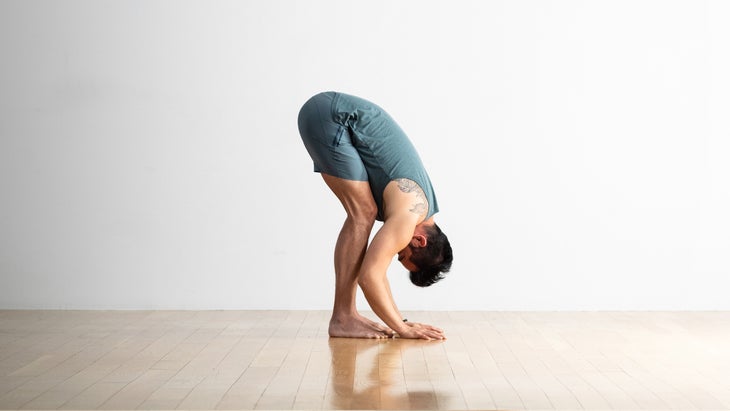
2. Standing Forward Bend with Crossed Legs
This variation on the classic yoga pose isolates the outer thigh and target your iliotibial (IT) band, hamstrings, lower back extensors, glutes, and calves.
It couldn’t be simpler. Stand with your feet hip-distance apart and pause here (see photo above). Then cross one leg behind the other, taking the pinky toes near one another, and shift the weight a little into your heels. Take a slight bend in your knees if you need. Stay here or walk your hands over to the right to intensify the stretch along your left IT band. Switch sides.
Practice Standing Forward Bend with Crossed Legs

3. Bridge Pose
Many runners don’t effectively activate the glutes to really power the running stride. Instead, they rely on the smaller and weaker hamstrings and lower back muscles for hip extension and pelvic stability. This can lead to strain and overuse injuries. This exercise does double duty by strengthening the glutes and hamstrings while also stretching the hip flexors.
As you lift your hips and reach them toward the backs of your knees in the stretch, it teaches you what it feels like to activate the glutes. You can then incorporate that awareness into your running so you don’t become too reliant on your hamstrings.
Practice Bridge Pose
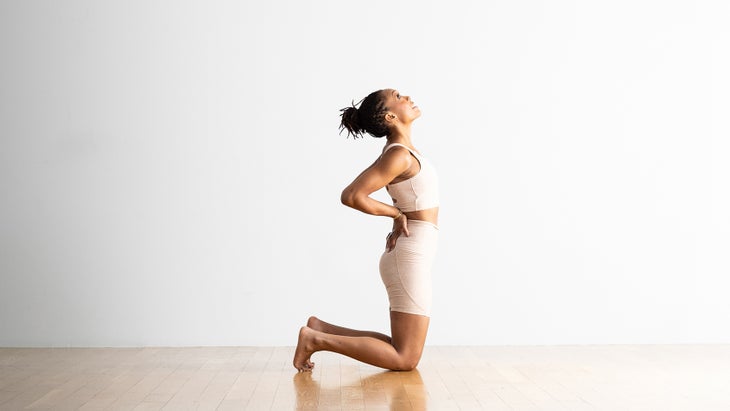
4. Camel Pose (Ustrasana)
Many runners end up with tight pecs and shoulders. Camel Pose not only stretches the upper body and chest but also those notoriously tight quads and hip flexors.
Start with your hands on your hips and focus on lifting your chest rather than leaning back. Stay here or, if it feels comfortable, try to touch your fingertips to your heels. Press your hips forward as you breathe into the pose to intensify the quad stretch.
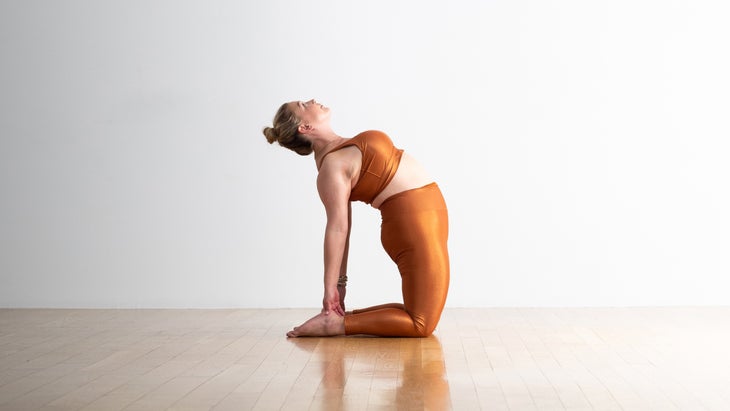
If you rest the tops of your feet on the floor and point your toes toward the wall behind you rather than keep them tucked, the pose also stretches the smaller muscles along the shins.
Practice Camel Pose
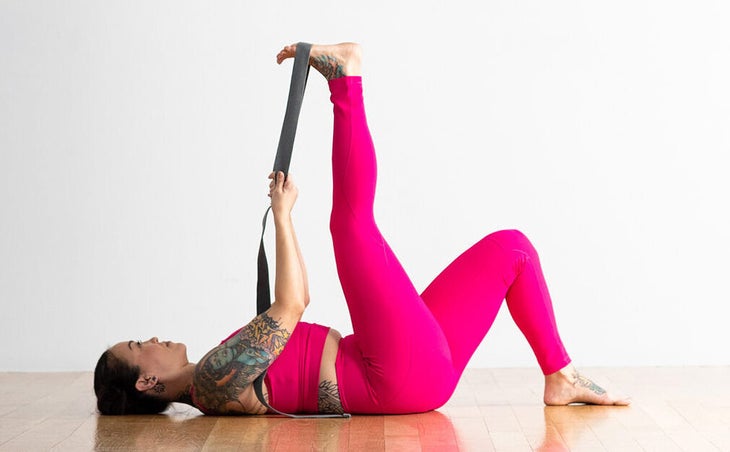 (Photo: Andrew Clark)
(Photo: Andrew Clark)5. Reclined Extended Hand-to-Big-Toe Pose Variation
This stretch opens the hips, inner thighs, and hamstrings. Unlike many stretches, it targets each leg individually, which allows you to control the intensity of the adductor stretch along the inner thighs. Use a strap or belt around your right foot and extend your heel toward the ceiling (see photo above) before you slowly lower your leg to the side. Don’t forget to switch sides.
You want to feel a stretch from your inner thigh to your heel. Keep your quads engaged.
Practice Reclined Extended Hand-to-Big-Toe Pose
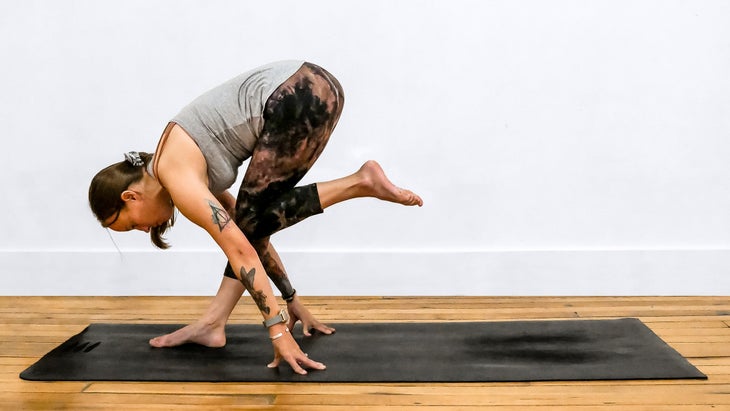
6. Flamingo Pose
This exercise is a more challenging version of the standing stretch in which you bend one knee and draw the heel toward your bum. Leaning forward lengthens the quads and hip flexors along your bent leg while also challenging your stability. Don’t forget to switch sides.
In each stretch, try to take the time to tune into your body and evaluate how you are feeling, which tissues feel tight or sore, where you feel trigger points, and give your body some grace.


